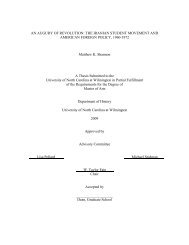HIERARCHAL INDUCTIVE PROCESS MODELING AND ANALYSIS ...
HIERARCHAL INDUCTIVE PROCESS MODELING AND ANALYSIS ...
HIERARCHAL INDUCTIVE PROCESS MODELING AND ANALYSIS ...
You also want an ePaper? Increase the reach of your titles
YUMPU automatically turns print PDFs into web optimized ePapers that Google loves.
eally well (Atanasova et al. 2007). While this framework can evaluate only able one<br />
state variable at the time, HIPM is capable of evaluating multiple variables simultaneously<br />
; however we are faced with an under-constrained optimization problem<br />
since we want to select models with data for only a couple of the variables. Using<br />
CIAO simulated data we were able to explore and investigate the response of HIPM<br />
for the phytoplankton dynamic in the Ross Sea. Even though we did not use real-life<br />
data the results generate conclusions. First, more data is not synonymous with fewer<br />
models being selected. This conclusion must be tested to see if it can be generalized<br />
to other ecosystems or if becomes obsolete with a refined and improved processlibrary.<br />
Secondly, the result that zooplankton contains more restrictive power than<br />
the other state variables was attained only through multiple experiments using a<br />
full data set. There is room for further work in the area of exploratory statistics<br />
with the median activation value in order to develop a formal procedure that would<br />
assist scientist in their decision making process for data collection.<br />
The number of processes taken into consideration for the Ross Sea ecosystem<br />
make for an extensive process-library, which creates models with very intricate and<br />
complex structures. A direction for improvement would be to look at some sort of<br />
measure of complexity for the models, somewhat motivated by the law of parsimony<br />
that states that the simplest explanation is often the best.This could be coupled<br />
with a measure of distance between models; this two concepts could potentially be<br />
of great value when comparing different models. However, at this point the more<br />
plausible and logical step for future research would be first to incorporate diatoms<br />
in the way in which phytoplankton is defined in the process library and second to<br />
switch from a mean square error to a maximum square error, which in my opinion<br />
would yield very different results. In the long run, this thesis could be the premise<br />
to a protocol towards decision making in the data collection process.<br />
68
















